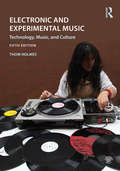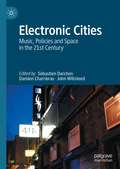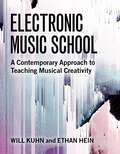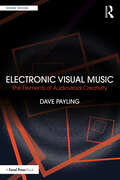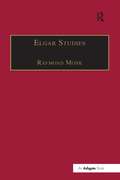- Table View
- List View
Electronic and Experimental Music: Technology, Music, and Culture (Media And Popular Culture Ser.)
by Thom HolmesElectronic and Experimental Music: Technology, Music, and Culture provides a comprehensive history of electronic music, covering key composers, genres, and techniques used in analog and digital synthesis. This textbook has been extensively revised with the needs of students and instructors in mind. The reader-friendly style, logical organization, and pedagogical features of the fifth edition allow easy access to key ideas, milestones, and concepts. New to this edition: • A companion website, featuring key examples of electronic music, both historical and contemporary. • Listening Guides providing a moment-by-moment annotated exploration of key works of electronic music. • A new chapter—Contemporary Practices in Composing Electronic Music. • Updated presentation of classic electronic music in the United Kingdom, Italy, Latin America, and Asia, covering the history of electronic music globally. • An expanded discussion of early experiments with jazz and electronic music, and the roots of electronic rock. • Additional accounts of the vastly under-reported contributions of women composers in the field. • More photos, scores, and illustrations throughout. The companion website features a number of student and instructor resources, such as additional Listening Guides, links to streaming audio examples and online video resources, PowerPoint slides, and interactive quizzes.
Electronic and Experimental Music: Technology, Music, and Culture
by Thom HolmesElectronic and Experimental Music: Technology, Music, and Culture provides a comprehensive history of electronic music, covering key composers, genres, and techniques used in analog and digital synthesis. This textbook has been extensively revised with the needs of students and instructors in mind. The reader-friendly style, logical organization, and pedagogical features of the fifth edition allow easy access to key ideas, milestones, and concepts. New to this edition: • A companion website, featuring key examples of electronic music, both historical and contemporary. • Listening Guides providing a moment-by-moment annotated exploration of key works of electronic music. • A new chapter—Contemporary Practices in Composing Electronic Music. • Updated presentation of classic electronic music in the United Kingdom, Italy, Latin America, and Asia, covering the history of electronic music globally. • An expanded discussion of early experiments with jazz and electronic music, and the roots of electronic rock. • Additional accounts of the vastly under-reported contributions of women composers in the field. • More photos, scores, and illustrations throughout. The companion website features a number of student and instructor resources, such as additional Listening Guides, links to streaming audio examples and online video resources, PowerPoint slides, and interactive quizzes.
Electronic and Experimental Music: Technology, Music, and Culture (Media And Popular Culture Ser.)
by Thom HolmesElectronic and Experimental Music: Technology, Music, and Culture, Sixth Edition, presents an extensive history of electronic music—from its historical beginnings in the late nineteenth century to its everchanging present—recounting the musical ideas that arose in parallel with technological progress. In four parts, the author details the fundamentals of electronic music, its history, the major synthesizer innovators, and contemporary practices. This examination of the music’s experimental roots covers the key composers, genres, and techniques used in analog and digital synthesis, including both art and popular music, Western and non-Western. NEW to this edition: A reorganized and revised chapter structure places technological advances within a historical framework Shorter chapters offer greater modularity and flexibility for instructors Discussions on the elements of sound, listening to electronic music, electronic music in the mainstream, Eurorack, and more An appendix of historically important electronic music studios around the globe Listening Guides throughout the book provide step-by-step annotations of key musical works, focusing the development of student listening skills. Featuring extensive revisions and expanded coverage, this sixth edition of Electronic and Experimental Music represents an comprehensive accounting of the technology, musical styles, and figures associated with electronic music, highlighting the music’s deep cultural impact.
Electronic and Experimental Music: Technology, Music, and Culture
by Thom HolmesElectronic and Experimental Music: Technology, Music, and Culture, Sixth Edition, presents an extensive history of electronic music—from its historical beginnings in the late nineteenth century to its everchanging present—recounting the musical ideas that arose in parallel with technological progress. In four parts, the author details the fundamentals of electronic music, its history, the major synthesizer innovators, and contemporary practices. This examination of the music’s experimental roots covers the key composers, genres, and techniques used in analog and digital synthesis, including both art and popular music, Western and non-Western. NEW to this edition: A reorganized and revised chapter structure places technological advances within a historical framework Shorter chapters offer greater modularity and flexibility for instructors Discussions on the elements of sound, listening to electronic music, electronic music in the mainstream, Eurorack, and more An appendix of historically important electronic music studios around the globe Listening Guides throughout the book provide step-by-step annotations of key musical works, focusing the development of student listening skills. Featuring extensive revisions and expanded coverage, this sixth edition of Electronic and Experimental Music represents an comprehensive accounting of the technology, musical styles, and figures associated with electronic music, highlighting the music’s deep cultural impact.
Electronic Cities: Music, Policies and Space in the 21st Century
by Sébastien Darchen Damien Charrieras John WillsteedThis book examines Electronic Dance Music (EDM) scenes in 18 cities across Africa, the Middle East, Europe, Asia, North America and Australia. It focuses on the historical development of these scenes, with an emphasis on the post-2000 context, including the COVID-19 pandemic and its far-reaching effects. Expert contributors highlight the influence of geographical contexts, as well as cultural and political histories, in the development of mainstream EDM scenes and underground Electronic Dance Music Cultures. This expansive work offers additional insights on cultural and creative policies, planning interventions and regulations associated with nightlife management, and provides a detailed analysis of current challenges inherent to the governance of EDM scenes in contemporary cities.
Electronic Inspirations: Technologies of the Cold War Musical Avant-Garde (The New Cultural History of Music Series)
by Jennifer IversonFor a decimated post-war West Germany, the electronic music studio at the WDR radio in Cologne was a beacon of hope. Jennifer Iverson's Electronic Inspirations: Technologies of the Cold War Musical Avant-Garde traces the reclamation and repurposing of wartime machines, spaces, and discourses into the new sounds of the mid-century studio. In the 1950s, when technologies were plentiful and the need for reconstruction was great, West Germany began to rebuild its cultural prestige via aesthetic and technical advances. The studio's composers, collaborating with scientists and technicians, coaxed music from sine-tone oscillators, noise generators, band-pass filters, and magnetic tape. Together, they applied core tenets from information theory and phonetics, reclaiming military communication technologies as well as fascist propaganda broadcasting spaces. The electronic studio nurtured a revolutionary synthesis of science, technology, politics, and aesthetics. Its esoteric sounds transformed mid-century music and continue to reverberate today. Electronic music--echoing both cultural anxiety and promise--is a quintessential Cold War innovation.
ELECTRONIC INSPIRATIONS NCHM C: Technologies of the Cold War Musical Avant-Garde (The New Cultural History of Music Series)
by Jennifer IversonFor a decimated post-war West Germany, the electronic music studio at the WDR radio in Cologne was a beacon of hope. Jennifer Iverson's Electronic Inspirations: Technologies of the Cold War Musical Avant-Garde traces the reclamation and repurposing of wartime machines, spaces, and discourses into the new sounds of the mid-century studio. In the 1950s, when technologies were plentiful and the need for reconstruction was great, West Germany began to rebuild its cultural prestige via aesthetic and technical advances. The studio's composers, collaborating with scientists and technicians, coaxed music from sine-tone oscillators, noise generators, band-pass filters, and magnetic tape. Together, they applied core tenets from information theory and phonetics, reclaiming military communication technologies as well as fascist propaganda broadcasting spaces. The electronic studio nurtured a revolutionary synthesis of science, technology, politics, and aesthetics. Its esoteric sounds transformed mid-century music and continue to reverberate today. Electronic music--echoing both cultural anxiety and promise--is a quintessential Cold War innovation.
Electronic Music (Cambridge Introductions To Music Ser.)
by Nick Collins Margaret Schedel Scott WilsonThis accessible Introduction explores both mainstream and experimental manifestations of electronic music. From early recording equipment to the most recent multimedia performances, the history of electronic music is full of interesting characters, fascinating and unusual music, and radical technology. Covering many different eras, genres and media, analyses of works appear alongside critical discussion of central ideas and themes, making this an essential guide for anyone approaching the subject for the first time. Chapters include key topics from synth pop to sound art, from electronic dance music to electrical instruments, and from the expression of pure sound to audiovisuals. Highly illustrated and with a wide selection of examples, the book provides many suggestions for further reading and listening to encourage students to begin their own experiments in this exciting field.
Electronic Music School: A Contemporary Approach to Teaching Musical Creativity
by Will Kuhn Ethan HeinElectronic Music School: A Contemporary Approach to Teaching Musical Creativity is a practical blueprint for teachers wanting to begin teaching music technology to secondary age students. Will Kuhn and Ethan Hein inspire classroom music teachers to expand beyond traditional ensemble-based music education offerings to create a culture of unique creativity and inclusivity at their schools. Part One offers an overview of the philosophical and institutional aspects of starting a music technology program, with a particular focus on the culture of electronic music surrounding digital music creation tools. Part Two dives deep into curricula for music lab classes, including several lesson examples and techniques. This section also includes abbreviated project plans for teachers who have fewer contact hours with their students. Part Three discusses how music technology courses can grow into a larger media creation program, how such a program can contribute to the broader school culture, and how project-based music learning effectively prepares students for careers in media. Electronic Music School also includes narratives from music technology students themselves, who often have an intuitive understanding of the future directions music technology programs can take.
Electronic Music School: A Contemporary Approach to Teaching Musical Creativity
by Will Kuhn Ethan HeinElectronic Music School: A Contemporary Approach to Teaching Musical Creativity is a practical blueprint for teachers wanting to begin teaching music technology to secondary age students. Will Kuhn and Ethan Hein inspire classroom music teachers to expand beyond traditional ensemble-based music education offerings to create a culture of unique creativity and inclusivity at their schools. Part One offers an overview of the philosophical and institutional aspects of starting a music technology program, with a particular focus on the culture of electronic music surrounding digital music creation tools. Part Two dives deep into curricula for music lab classes, including several lesson examples and techniques. This section also includes abbreviated project plans for teachers who have fewer contact hours with their students. Part Three discusses how music technology courses can grow into a larger media creation program, how such a program can contribute to the broader school culture, and how project-based music learning effectively prepares students for careers in media. Electronic Music School also includes narratives from music technology students themselves, who often have an intuitive understanding of the future directions music technology programs can take.
Electronic Visual Music: The Elements of Audiovisual Creativity (Sound Design)
by Dave PaylingElectronic Visual Music is a comprehensive guide to the composition and performance of visual music, and an essential text for those wanting to explore the history, current practice, performance strategies, compositional methodologies and practical techniques for conceiving and creating electronic visual music. Beginning with historical perspectives to inspire the reader to work creatively and develop their own individual style, visual music theory is then discussed in an accessible form, providing a series of strategies for implementing ideas. Including interviews with current practitioners, Electronic Visual Music provides insight into contemporary working methods and gives a snapshot of the state of the art in this ever-evolving creative discipline. This book is a valuable resource for artists and practitioners, as well as students, educators and researchers working in disciplines such as music composition, music production, video arts, animation and related media arts, who are interested in informing their own work and learning new strategies and techniques for exploration and creative expression of electronic visual music.
Electronic Visual Music: The Elements of Audiovisual Creativity (Sound Design)
by Dave PaylingElectronic Visual Music is a comprehensive guide to the composition and performance of visual music, and an essential text for those wanting to explore the history, current practice, performance strategies, compositional methodologies and practical techniques for conceiving and creating electronic visual music. Beginning with historical perspectives to inspire the reader to work creatively and develop their own individual style, visual music theory is then discussed in an accessible form, providing a series of strategies for implementing ideas. Including interviews with current practitioners, Electronic Visual Music provides insight into contemporary working methods and gives a snapshot of the state of the art in this ever-evolving creative discipline. This book is a valuable resource for artists and practitioners, as well as students, educators and researchers working in disciplines such as music composition, music production, video arts, animation and related media arts, who are interested in informing their own work and learning new strategies and techniques for exploration and creative expression of electronic visual music.
Electronica, Dance and Club Music
by Mark J. ButlerDiscos, clubs and raves have been focal points for the development of new and distinctive musical and cultural practices over the past four decades. This volume presents the rich array of scholarship that has sprung up in response. Cutting-edge perspectives from a broad range of academic disciplines reveal the complex questions provoked by this musical tradition. Issues considered include aesthetics; agency; 'the body' in dance, movement, and space; composition; identity (including gender, sexuality, race, and other constructs); musical design; place; pleasure; policing and moral panics; production techniques such as sampling; spirituality and religion; sub-cultural affiliations and distinctions; and technology. The essays are contributed by an international group of scholars and cover a geographically and culturally diverse array of musical scenes.
Electronica, Dance and Club Music
by MarkJ. ButlerDiscos, clubs and raves have been focal points for the development of new and distinctive musical and cultural practices over the past four decades. This volume presents the rich array of scholarship that has sprung up in response. Cutting-edge perspectives from a broad range of academic disciplines reveal the complex questions provoked by this musical tradition. Issues considered include aesthetics; agency; 'the body' in dance, movement, and space; composition; identity (including gender, sexuality, race, and other constructs); musical design; place; pleasure; policing and moral panics; production techniques such as sampling; spirituality and religion; sub-cultural affiliations and distinctions; and technology. The essays are contributed by an international group of scholars and cover a geographically and culturally diverse array of musical scenes.
Electronically Yours: Vol. I: My Autobiography
by Martyn WareThis is a music autobiography to remember. This is the story of Martyn Ware. The Human League and Heaven 17 were among some of the most pioneering bands of the 1980s, with Ware having played an integral role in each of their numerous successes. A young lad from the heart of post-war Sheffield, Ware formed The Human League a few years out of school in his early twenties. Described by David Bowie as 'the future of music', it wasn't long before the band become known for their innovative and infectiously catchy singles such as 'Being Boiled', touring with the likes of Siouxsie and the Banshees and Iggy Pop before Ware's departure. Heaven 17 followed suit, with their soon-to-be classic albums, Penthouse & Pavement and The Luxury Gap, featuring several colossal hits. Ground-breaking icons in new wave and synth pop, both groups remain some of the biggest-selling bands across the UK and worldwide. In Electronically Yours, Martyn takes us through his incredible route to stardom; from his austere upbringing in various council houses and close teenage friendship with former-bandmate Phil Oakey, to the white-hot experimentation in the 'Synth Britannia' era and his production career, which allowed him to work with some of the world's greatest singers, including Tina Turner. But it's not just his life inside the industry which is compelling; a proud socialist, Martyn writes poignantly about politics - how it can be a soulful, personal, moral duty - and its role in his music creation and Britain today. With charming meditations on culture, humour, travel and sport, Martyn also shares his love of 60s films, explains why Venice is the most beautiful city in the world, and reveals how Sheffield Wednesday has forever been his first and eternal passion. A huge page-turner and always warmly told, Electronically Yours sees Martyn talk candidly for the very first time about his extraordinary journey. Discover amusing anecdotes, raw confessions, and moving reflections of a life well and truly lived at the height of the music industry.
Elements in Popular Music: Advances In Electric Guitar Playing, Technology, And Culture (Elements In Popular Music Ser.)
by Jan-Peter Herbst Alexander Paul VallejoElements of Music
by Joseph N. StrausElements of Music, Fourth Edition, is an introduction to music fundamentals for music majors and non-majors. Organized into brief, digestible, self-contained lessons, each of which is followed by exercises and in-class activities, the text offers instructors flexibility in how they teach music fundamentals. Unmatched concision and clarity make learning fundamentals simple. Throughout the text, a core repertoire introduces students to fundamental concepts, helping students connect fundamentals to music they enjoy. And with the new Oxford fourth edition, the text offers more resources than ever for students to complete fundamentals work online.
Elements of Sonata Theory: Norms, Types, and Deformations in the Late-Eighteenth-Century Sonata
by James Hepokoski Warren DarcyElements of Sonata Theory is a comprehensive, richly detailed rethinking of the basic principles of sonata form in the decades around 1800. This foundational study draws upon the joint strengths of current music history and music theory to outline a new, up-to-date paradigm for understanding the compositional choices found in the instrumental works of Haydn, Mozart, Beethoven, and their contemporaries: sonatas, chamber music, symphonies, overtures, and concertos. In so doing, it also lays out the indispensable groundwork for anyone wishing to confront the later adaptations and deformations of these basic structures in the nineteenth and earlier twentieth centuries. Combining insightful music analysis, contemporary genre theory, and provocative hermeneutic turns, the book brims over with original ideas, bold and fresh ways of awakening the potential meanings within a familiar musical repertory. Sonata Theory grasps individual compositions-and each of the individual moments within them-as creative dialogues with an implicit conceptual background of flexible, ever-changing historical norms and patterns. These norms may be recreated as constellations "compositional defaults," any of which, however, may be stretched, strained, or overridden altogether for individualized structural or expressive purposes. This book maps out the terrain of that conceptual background, against which what actually happens-or does not happen-in any given piece may be assessed and measured. The Elements guides the reader through the standard (and less-than-standard) formatting possibilities within each compositional space in sonata form, while also emphasizing the fundamental role played by processes of large-scale circularity, or "rotation," in the crucially important ordering of musical modules over an entire movement. The book also illuminates new ways of understanding codas and introductions, of confronting the generating processes of minor-mode sonatas, and of grasping the arcs of multimovement cycles as wholes. Its final chapters provide individual studies of alternative sonata types, including "binary" sonata structures, sonata-rondos, and the "first-movement form" of Mozart's concertos.
Elements of Sonata Theory: Norms, Types, and Deformations in the Late-Eighteenth-Century Sonata
by James Hepokoski Warren DarcyElements of Sonata Theory is a comprehensive, richly detailed rethinking of the basic principles of sonata form in the decades around 1800. This foundational study draws upon the joint strengths of current music history and music theory to outline a new, up-to-date paradigm for understanding the compositional choices found in the instrumental works of Haydn, Mozart, Beethoven, and their contemporaries: sonatas, chamber music, symphonies, overtures, and concertos. In so doing, it also lays out the indispensable groundwork for anyone wishing to confront the later adaptations and deformations of these basic structures in the nineteenth and earlier twentieth centuries. Combining insightful music analysis, contemporary genre theory, and provocative hermeneutic turns, the book brims over with original ideas, bold and fresh ways of awakening the potential meanings within a familiar musical repertory. Sonata Theory grasps individual compositions-and each of the individual moments within them-as creative dialogues with an implicit conceptual background of flexible, ever-changing historical norms and patterns. These norms may be recreated as constellations "compositional defaults," any of which, however, may be stretched, strained, or overridden altogether for individualized structural or expressive purposes. This book maps out the terrain of that conceptual background, against which what actually happens-or does not happen-in any given piece may be assessed and measured. The Elements guides the reader through the standard (and less-than-standard) formatting possibilities within each compositional space in sonata form, while also emphasizing the fundamental role played by processes of large-scale circularity, or "rotation," in the crucially important ordering of musical modules over an entire movement. The book also illuminates new ways of understanding codas and introductions, of confronting the generating processes of minor-mode sonatas, and of grasping the arcs of multimovement cycles as wholes. Its final chapters provide individual studies of alternative sonata types, including "binary" sonata structures, sonata-rondos, and the "first-movement form" of Mozart's concertos.
Eleven Late String Quartets: Opp. 74, 76 and 77, Complete
by Joseph Haydn"It was from Haydn that I first learned the true way to compose quartets." — Mozart Eleven Late String Quartets marks the first volume in a projected monumental undertaking — the complete Haydn string quartets. Players and students, music historians, and Haydn lovers will have inexpensive access to a uniform, strongly bound, and clearly printed modern edition of Haydn's finest pieces in complete score. Musicians, music students, and music publishers have a difficult time keeping up with Haydn, whose ceaseless production of original, first-rate work was legendary. He essayed most of the recognized genres, confessing upon several a legacy of expanded possibilities and clearly defined, characteristic form. Among these may be mentioned the symphony, the sonata, and perhaps most notably, the quartet. In a period of 50 years, Haydn (1732–1809) composed over 80 string quartets. Scholars are still debating questions of attribution and even completeness (unknown works by Haydn still turn up) and music lovers have had to make do with scattered, out-of-date, out-of-print editions of a few of the more familiar quartets. Haydn's affinity to the quartet began with his earliest works, when he perhaps more than anyone established the 4-movement structure of chamber music. In common with truly great and complete artists, who surpass early innovation to achieve their greatest work at the end, Haydn's last quarters are his best. This work contains the full scores of Op. 74, Nos. 1–3 (including The Horseman); Op. 76, Nos. 1–6 (including The Bell, The Donkey, Emperor, and Sunrise); and Op. 77, Nos. 1, 2 (including Wait till the clouds roll by). Large, readable noteheads, ample margins for fingerings, etc., opaque paper and permanent binding make this a fundamental addition to music libraries and musicians' repertories.
Elgar Studies
by Raymond MonkEdward Elgar rose from obscurity to become the most popular English composer of his day. Elgar's music is known world-wide and works such as the 'Enigma Variations' and 'The Dream of Gerontius' together with the two symphonies and the two concertos have established him as one of the greatest British composers of all time. The Elgar Society was founded in 1951 to further the cause of Elgar's music and the present volume of essays has been compiled as an expression of gratitude for the work that it has done. These essays reflect the variety and richness of Elgar's music and the debate that this music continues to encourage. The book is not simply for academics however; lovers of music in general will find much to entertain them and it will add greatly to our appreciation of Elgar.
Elgar Studies
by Raymond MonkEdward Elgar rose from obscurity to become the most popular English composer of his day. Elgar's music is known world-wide and works such as the 'Enigma Variations' and 'The Dream of Gerontius' together with the two symphonies and the two concertos have established him as one of the greatest British composers of all time. The Elgar Society was founded in 1951 to further the cause of Elgar's music and the present volume of essays has been compiled as an expression of gratitude for the work that it has done. These essays reflect the variety and richness of Elgar's music and the debate that this music continues to encourage. The book is not simply for academics however; lovers of music in general will find much to entertain them and it will add greatly to our appreciation of Elgar.
Eliakim Doolittle: The Collected Works (Music of the New American Nation: Sacred Music from 1780 to 1820)
by Karl Kroeger Maxine Fawcett-YeskeThis volume brings together 79 sacred tunes by two Connecticut composers: Eliakim Doolittle, who wrote psalm and fuging tunes in an unpretentious, familiar idiom, and Timothy Olmsted, who wrote psalm tunes in a more sophisticated, florid musical style. This final edition in the Music of the New American Nation series includes a comprehensive index of tune names and first lines for all fifteen volumes.
Eliakim Doolittle: The Collected Works (Music of the New American Nation: Sacred Music from 1780 to 1820)
by Karl Kroeger Maxine Fawcett-YeskeThis volume brings together 79 sacred tunes by two Connecticut composers: Eliakim Doolittle, who wrote psalm and fuging tunes in an unpretentious, familiar idiom, and Timothy Olmsted, who wrote psalm tunes in a more sophisticated, florid musical style. This final edition in the Music of the New American Nation series includes a comprehensive index of tune names and first lines for all fifteen volumes.
Elite Art Worlds: Philanthropy, Latin Americanism, and Avant-garde Music (Currents in Latin American and Iberian Music)
by Eduardo HerreraThe Centro Latinoamericano de Altos Estudios Musicales (CLAEM) in Buenos Aires operated for less than a decade, but by the time of its closure in 1971 it had become the undeniable epicenter of Latin American avant-garde music. Providing the first in-depth study of CLAEM, author Eduardo Herrera tells the story of the fellowship program--funded by the Rockefeller Foundation and the Di Tella family--that, by allowing the region's promising young composers to study with a roster of acclaimed faculty, produced some of the most prominent figures within the art world, including Rafael Aponte Ledeé, Coriún Aharonián, and Blas Emilio Atehortúa. Combining oral histories, ethnographic research, and archival sources, Elite Art Worlds explores regional discourses of musical Latin Americanism and the embrace, articulation, and resignification of avant-garde techniques and perspectives during the 1960s. But the story of CLAEM reveals much more: intricate webs of US and Argentine philanthropy, transnational currents of artistic experimentation and innovation, and the role of art in constructing elite identities. By looking at CLAEM as both an artistic and philanthropic project, Herrera illuminates the relationships between foreign policy, corporate interests, and funding for the arts in Latin America and the United States against the backdrop of the Cold War.
